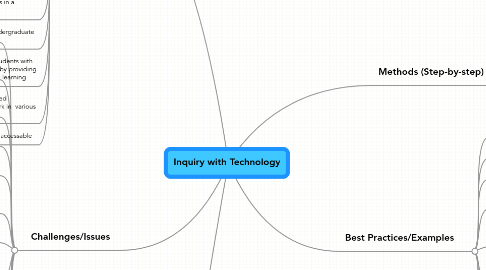Inquiry with Technology
저자: Wendy Drexler


1. Benefits
1.1. Makes students enthusiastic about showing work to worldwide audience.
1.2. Encourages collaboration
1.3. Can be used for literacy learning.
1.4. Promotes interaction, active engagement, participation and connection to outside world.
1.5. Access to primary source documents
1.6. Encourages critical thinking
1.7. Resources are both current and comprehensive from primary sources and various layouts
1.8. Increase student engagement and achievement through providing support, meaningful context, and strong learning scaffolds
1.9. Database searching inspires investigative learning techniques that are particularly useful in historical inquiry
1.10. Students were more engaged & motivated, collaborated better, gained internet skills, and generated interest outside the classroom
1.11. Benefits outweigh the frustrations of technology in inquiry based learning.
1.12. Teaches practical technology skills.
1.13. students who are engaged in constructing historical accounts have the opportunity to develop perspectives, attributes, and critical thinking skills required of informed citizens in a democratic society
1.14. Engages Large Undergraduate Classes Efficiently
1.15. can help students with disabilities by providing customized learning
1.16. Develops an advanced technological network in various institutions
1.17. makes science accessable
2. Challenges/Issues
2.1. Can be expensive
2.2. Teachers are overwhelmed with technology and don't know how to use it.
2.3. Misconceptions and mistakes may come without direct guidance
2.4. Poor integration into the classroom by teachers
2.5. Lower SES students don't have access to technology at home.
2.6. Students have trouble with some of the cognitive processes required of inquiry learning.
2.7. Students without teacher guidance might get lost
2.8. Without teacher led instruction, students don't participate as much.
2.9. Short-term memory may be overtaxed; long-term knowledge will not be gained
2.10. Provide quality training for all educators that incorporates technology
2.11. Teaching strategies, learning methods, and curriculum must be restructured
2.12. Motivation, accessibility of investigation techniques, lack of background knowledge, too much information on the web
2.13. Cost of Technology Implementation
3. Assessment
3.1. Webstreaming offered a valuable evaluation tool for analyzing student progress.
3.2. Interactive discussion boards between both teacher and students increased student learning.
3.3. Various Blog Networks
3.4. Some research studies found minimally guided studies performed worse than their direct guided peers
4. Best Practices/Examples
4.1. Learn for Use model
4.2. Use technology to report research
4.3. Let students be "historians"
4.4. bring in outside experts to give student insight.
4.5. Web Based teacher communities for sharing examples of inquiry-based activities
4.6. Teacher-run database safe for students to search accurate information
4.7. Communication channels, information resources, and various management tools
4.7.1. New node
